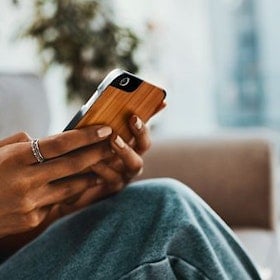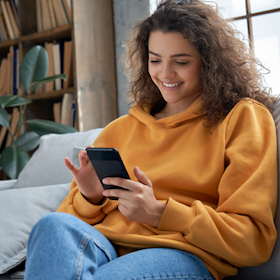With the variety of display sizes that are beginning to crop up in the mobile market many folks are finding it difficult to decide between a larger screen and a smaller one. How big is too big and how small can you go before it becomes an inconvenience?
As with many areas in technology there is no clear-cut answer, despite what the ‘fanbois’ on either side claim. In order to help you come to an educated decision we’ve decided to lay out the pros and cons that come along with screen sizes in order to help you decide for yourself which sounds more likely to make you happy.

Size vs Comfort
Size vs Comfort is probably the most obvious issue with screen sizes, although definitely not the most clear-cut. How large a display is often dictates the overall size of a handset. As such this impacts things like how manageable the phone is to hold in your hand, or how comfortable it is when kept in a pocket.
In this department the automatic response would be that the smaller the phone is then the more comfortable it will be. It makes sense. A smaller device is unlikely to cause you to stretch your hands awkwardly or create a particularly obvious presence in your pants pocket. This view is accurate in many ways. However, there are more things to take in to consideration than holding a phone or storing it during transport.
For instance, larger screens are generally better for typing on. Many users find that small screens cause them to cramp their hands together uncomfortably when sending texts or emails. As such your comfort when actually operating the device may differ to how good it feels in your pocket.
The obvious solution is to try out any phone of a specific size before you buy. Either borrow a friend’s phone or have a fiddle with a display model in-store. It doesn’t even have to be the same phone, just one with the same or similarly sized screen. Just remember that if it’s a size that you’re not used to it will take a few minutes to adjust. The larger the difference between the phone in question and your current norm the larger the amount of time it will likely take you to get used to handling it.
It’s also important to remember that as technology advances we’re seeing thinner and thinner devices. This makes a noticeable difference when keeping a phone in your pocket. It can also allow for a larger device to fit easily in to your pants without as noticeable a presence.
Once again it will depend on your own personal size, as well as the kind of clothing you wear. Jeans, for instance, tend to have tighter pockets than cargo pants or shorts. As such a thinner or smaller device will probably be required to maintain your current comfort levels. If you keep your phone in a bag then obviously that will factor in to how easily you find the handset to transport.
Media and Browsing
Obviously both web browsing and visual media will benefit from a larger display. Browsing especially becomes a much more easily navigable affair with the increase in size of text, images and links. One of the pluses here is that where a user might normally find themselves constantly zooming in to read text and then zoom out to view an image in the same article, a larger screen can often mean that no zooming is required at all.
There’s also the purely visual aspect of a well-laid out mobile website on a larger display when compared to a smaller. For many users, bigger images and more readily readable text help create a much more engaging browsing experience.
Video content is benefited in the same way. Of course some folk find that they’re just as engaged by a 3.5 inch screen as a 4.5, but as you can imagine they tend to be in the minority. Bigger screens usually mean less eye-strain and more easily made-out images for your viewing pleasure.
Smaller displays do have one ace up their sleeve in this department, in that they often have a higher pixel density. For example, a 3.5 inch display with a resolution of 480x800 will have the same number of pixels as a 4.5 inch display with the same resolution. As a result the pixels will be crammed in more closely and the image will be more crisp. It’s often not particularly noticeable for watching films, but does come in to play for things like text rendering and browsing. This is yet another area where it’s up to the user to decide which is more preferable; picture clarity or picture size.
Battery Usage
Obviously a larger screen will use up more of your charge than a smaller display of the same kind. As such it’s important to keep battery consumption in mind when looking at handsets.
The problem with judging a device by its screen in terms of energy consumption is that different devices manage battery power with extremely fluctuating success rates. Often, the most accurate way to judge a phone’s battery retention is by either asking a friend or reading multiple reviews.
There are also other features such as LTE connectivity, dual-core CPUs and the soon-to-come quad-core CPUs that can also drain power significantly. Devices with multiple features, i.e. a dual-core 4G LTE device with a 4.7 inch display, will often have larger than normal batteries to compensate.
Batteries are measured in terms of milliamp hours (mAh). Traditionally smartphones batteries have tended to measure between 1500 and 1650 mAh. With the new generation of battery-hungry features, however, we’re starting to see a significant jump in that statistic. It’s not uncommon now to see a phone with between 1850 and 2100 mAh. This can be another indicator as to whether or not a device’s large screen may adversely affect available battery life, but is not as reliable as asking a friend or reading reviews.
In Summary
Basically there is no right or wrong when it comes to display sizes. All that it really comes down to is the preference of the user in each area that is affected by a change in screen size. Weight up the pros and cons the best you can and come to your own conclusion. Ultimately it shouldn’t matter too much if you aim between the 3.5 and 4.5 inch range, as those sizes and everything in-between are all becoming very popular. If you feel like stepping outside this range then that’s fine too, but make sure you’re comfortable with the decision. Just do the best you can with the information we’ve made available to you and go with whatever feels right. Screen size is an important aspect of your device, but at the end of the day it’s rarely sole reason that a potential customer will be seriously attracted to a smartphone.
Related Articles
Find Better Phones and Plans
Hundreds of cell phone plans unpacked. All the facts. No surprises.



































